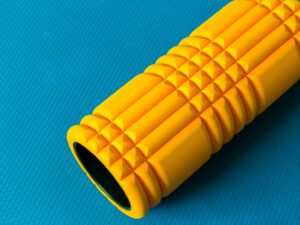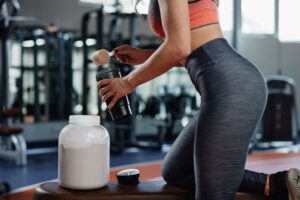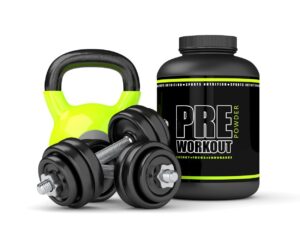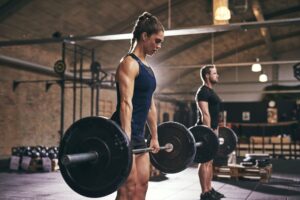
Uncovering the best upper chest exercises for both men and women is essential to obtaining a strong, balanced body. A powerful upper chest improves your overall strength, enhances athletic performance, and promotes better posture. This comprehensive guide will explore various exercises and techniques targeting the often neglected upper chest muscles.
We’ll start by discussing the incline bench press – the foundation of upper chest development – while comparing dumbbell and barbell variations. Then, we’ll explore additional exercises to target your entire chest, including isolation movements for sculpting hard-to-reach areas and incorporating different equipment in your workouts.
Moreover, we will emphasize the importance of prioritizing warm-ups and stretching before training sessions with dynamic stretches specific to chest workouts and foam rolling techniques. Furthermore, you’ll learn about an underrated exercise called the guillotine press that can significantly contribute to your chest development when executed properly.
Last, we will discuss resistance training versus super-slow methods for optimal muscle growth and supplementing the best upper chest exercises for men and women with pre-workout ingredients for improved performance and post-workout recovery nutrition strategies.
Table of Contents:
- Benefits of a Strong Upper Chest for Men and Women
- Incline Bench Press – The Foundation of Upper Chest Development
- Additional Exercises to Target All Areas of Your Chest
- Prioritizing Warm-Ups & Stretching Before Training Sessions
- Guillotine Press – An Underrated Exercise for Chest Development
- Resistance Training vs Super-Slow Methods for Chest Growth
- Supplementing Your Upper Chest Workouts for Enhanced Results
- FAQs in Relation to Best Upper Chest Workout for Men and Women
- What exercises should I include in my upper chest workout?
- How often should I do an upper chest workout?
- Are there any modifications to the exercises that can be done for different fitness levels?
- What are some tips for getting the most out of an upper chest workout?
- Is it necessary to use weights when doing an upper chest workout?
- Conclusion
Benefits of a Strong Upper Chest for Men and Women
Developing a solid upper chest not only improves one’s physique but also aids in increasing overall strength when pushing or pressing heavier loads.
Improved Overall Strength
Strengthening the upper chest muscle fibers can help develop other upper body muscles, such as shoulders, triceps, and back, thus leading to improved overall strength, enhanced athletic performance, and better posture. This increased strength can carry over into other aspects of daily life, making everyday tasks easier and preventing injuries.
Enhanced Athletic Performance
Having a developed upper chest can significantly improve performance in sports requiring powerful upper body movements, such as swimming, boxing, or tennis. Additionally, many functional training exercises like the overhead press rely on activating these upper chest muscle fibers for optimal results.
Better Posture
- Pectoralis Major Muscle: Strengthening your pectoralis major muscle helps maintain proper shoulder alignment by preventing rounded shoulders often caused by weak chest muscles.
- Sternal Head: Developing the sternal head (the lower portion) assists with maintaining an upright posture due to its role in shoulder flexion.
- Muscle Balance: Focusing on building muscle evenly across your entire chest prevents imbalances which could lead to poor posture or injury over time.
By incorporating targeted chest exercises into your workout routine, you can reap the benefits of an upper body and improve overall health and fitness.
Moving on to the next heading, we will explore how the incline bench press is an essential foundation for developing your upper chest muscles.
Incline Bench Press – The Foundation of Upper Chest Development

One of the best upper chest exercises is the incline bench press. This compound movement targets the upper portion of your upper pecs and engages your shoulders and triceps. Performing 3 or 4 sets of 6 to 8 reps on an incline bench set at a 30-45° angle can yield significant results over time.
Proper Form and Technique
To ensure maximum upper chest activation, it’s crucial to maintain proper form during this exercise. Start by lying down on an incline bench with your feet firmly planted on the ground, gripping the barbell slightly wider than shoulder-width apart. Lower the bar gradually towards your upper chest level while keeping your elbows slightly bent at an angle from your body. Push back up until your arms are fully extended, focusing on contracting those chest muscles.
Dumbbell vs. Barbell Variations
- Incline Dumbbell Bench Press: Using dumbbells allows for a greater range of motion compared to a traditional barbell press, targeting different muscle fibers within both the sternal head and clavicular head (upper) portions of the pecs.
- Incline Barbell Press: A classic variation that provides more stability due to its fixed path movement; however, it may limit some individuals’ ability to engage specific areas of their pecs as effectively as when using dumbbells.
The key is finding which variation works best for you based on personal preference and comfort level, ensuring proper form and technique are maintained throughout each rep and set.
The incline bench press is an essential exercise for building a solid upper chest, and when done with proper form and technique, it can be highly effective. By adding additional exercises to target all areas of the chest, you can further sculpt your physique while mixing up workouts with different equipment.
Additional Exercises to Target All Areas of Your Chest
To achieve optimal results, incorporate various exercises to target your entire chest into your workout routine. These include the close-grip bench press, overhead press, resistance band push-ups (which add extra resistance), the hex press (specifically targeting the upper pecs), weighted dips (great as a finisher movement), and decline push-ups.
Isolation Exercises for Sculpting Hard-to-Reach Areas
In addition to compound movements like the incline bench press, isolation exercises can help sculpt hard-to-reach areas in your chest muscles. For example, dumbbell chest flys isolate the pectoralis muscle fibers and provide an excellent stretch at the bottom of each rep. Incorporate these into your chest day by performing 3 sets of 10-12 reps with lighter weights to maintain proper form.
Mixing up Workouts with Different Equipment
- Dumbbells: Switching from barbells to dumbbells can increase range-of-motion and activate more stabilizer muscles during pressing exercises such as the dumbbell bench press.
- Cable Machines: Cable crossovers are another great exercise that targets both the upper and lower chest muscles while providing constant tension throughout each repetition. Check out this guide on how to perform cable crossovers for upper chest development.
- Bands and Suspension Trainers: Resistance bands and suspension trainers, like the TRX system, can be used for various chest exercises that challenge your muscles in unique ways.
Using isolation exercises in your chest training routine can help target hard-to-reach areas of the chest for a more complete workout. To maximize the effectiveness of your chest day, warm-ups and stretching should be done prior to training.
Prioritizing Warm-Ups & Stretching Before Training Sessions
Prioritizing proper warm-ups and stretching exercises is essential when incorporating new upper-chest-focused movements into your training regimen. This will help prevent injury while effectively targeting desired pec muscles for maximum growth and strength gains. This section will discuss dynamic stretches specific to chest workouts and foam rolling techniques.
Dynamic Stretches Specific to Chest Workouts
Before starting any dynamic stretches, ensure you have warmed up with some light cardio or bodyweight exercises for at least 5-10 minutes. Some effective dynamic stretches for the chest include:
- Arm circles: Perform forward and backward arm circles in a controlled manner, gradually increasing the range of motion.
- Gently draw one arm across the torso, aiming towards the opposite shoulder, until a slight tension is felt in the upper back and shoulders.
- Chest opener: Stand tall with feet hip-width apart, interlace fingers behind your back, and straighten arms as much as possible while lifting them away from the body to open up the chest muscles.
Foam Rolling Techniques

Foam rolling can be an excellent addition to your pre-workout routine by helping release tightness in muscles such as the pectoralis major muscle (chest) and surrounding areas like shoulders or triceps. Here are some foam rolling techniques for the chest:
- Chest roll: Place a foam roller horizontally under your upper chest and slowly roll back and forth to target tight spots.
- Upper back roll: Position the foam roller vertically along your spine, cross your arms over your chest, and gently rock side-to-side to release tension in the back muscles.
By incorporating these warm-up exercises into your program before starting an intense upper chest workout, you’ll reduce the risk of injury and ensure that you’re targeting muscle fibers effectively for optimal growth and strength gains.
Prioritizing warm-ups and stretching before training sessions is essential for optimal performance, injury prevention, and improved mobility. Moving on to the next exercise in our chest workout series, we will discuss the underrated guillotine press and how it can be beneficial for chest development.
Guillotine Press – An Underrated Exercise for Chest Development
The guillotine press is a lesser-known exercise that performs an extreme stretch on the pecs with light weights. Incorporating this movement 2 or 3 times in your chest training routine can significantly improve chest development over time.
Proper Execution and Safety Precautions
Lying on a flat bench, feet firmly planted, grip the barbell with an over-shoulder span and lift from its rack. Grasp a barbell using a slightly wider than shoulder-width grip and unrack it from the supports above you. Lower the bar slowly towards your upper chest while keeping your elbows flared out at approximately 90 degrees. Once the bar reaches just above your collarbone, pause briefly before pressing it back up to full arm extension. It’s essential to use lighter weights compared to traditional bench presses, as heavier loads may increase injury risk due to increased stress placed upon shoulder joints during this movement.
Benefits of Incorporating Unique Exercises
- Variety: Including exercises like guillotine presses into your workout routine helps prevent boredom and keeps training sessions fresh and engaging.
- Muscle Activation: This exercise’s unique angle of attack targets different muscle fibers within the upper chest, leading to a more balanced overall chest development.
- Injury Prevention: By working for underutilized muscle groups through movements such as these, you reduce imbalances between opposing muscle groups which could potentially contribute toward injuries later down the line if left unaddressed (source).
The Guillotine Press is an underrated exercise for chest development that can be beneficial when incorporated into a workout routine. Resistance training and super-slow methods are two distinct approaches to chest growth, each with its own advantages and drawbacks.
Resistance Training vs Super-Slow Methods for Chest Growth
When it comes to building a strong and well-developed upper chest, the debate between traditional resistance training and super-slow methods often arises. Studies have indicated that conventional resistance training is more efficient for enhancing total strength than slow-paced workouts on their own.
Advantages of High-Intensity Interval Training (HIIT)
By incorporating HIIT into your chest training routine, you can maximize muscle growth and benefit from increased calorie burn and fat loss.
Balancing Workout Intensity for Optimal Muscle Growth
To achieve the best results in terms of muscle growth and strength gains, it’s essential to strike a balance between high-intensity exercises like the bench press or incline presses and slower-paced movements such as super-slow push-ups. This combination allows you to engage different muscle fibers within your upper pecs while preventing overtraining or injury.
- Incorporate compound exercises like incline presses or close-grip bench press into your routine for maximum upper chest activation.
- Add isolation movements such as dumbbell chest fly or overhead press to target specific upper chest areas.
- Include HIIT workouts for a well-rounded fitness regimen promoting muscle growth and weight loss.
Combining traditional resistance training with super-slow methods allows you to create an effective workout plan tailored to your goals and needs. Remember, consistency is key to achieving optimal results in strength gains and overall upper chest development.
Resistance training is an effective way to build the upper chest muscles; however, it should be balanced with super-slow methods for optimal muscle growth. Supplementing your workouts can enhance results and help you reach your goals faster.
Supplementing Your Upper Chest Workouts for Enhanced Results

In addition to targeted exercises, supplementing with whey protein powder and pre-workout supplements containing ingredients such as caffeine, beta-alanine, and citrulline malate may further enhance muscular endurance and promote lipid oxidation within the body. This can lead to more significant gains in size and functionality throughout the chest.
Pre-workout Ingredients for Improved Performance
- Caffeine: A popular stimulant that increases alertness, focus, and energy levels during workouts. It also has been shown to improve muscle endurance by reducing perceived exertion.
- Beta-Alanine: An amino acid that helps buffer lactic acid buildup in muscles during high-intensity exercise. This can help delay fatigue and increase overall workout performance.
- Citrulline Malate: A combination of the amino acid citrulline and malic acid, which has been found to boost nitric oxide production leading to improved blood flow, oxygen delivery, and nutrient transport to working muscles.
Post-workout Recovery Nutrition
To maximize your upper chest exercise results, it’s essential to fuel your body before training and after completing a session. A post-workout meal or shake composed of fast-digesting carbohydrates such as dextrose and high-quality proteins like whey isolate should be consumed for optimal recovery. Additionally, consuming foods rich in antioxidants, vitamins, and minerals can help reduce inflammation and promote muscle repair.
FAQs in Relation to Best Upper Chest Workout for Men and Women
What exercises should I include in my upper chest workout?
Include a combination of compound and isolation exercises for optimal upper chest development. Some effective exercises are incline press, incline dumbbell press, overhead press, cable chest flys, dumbbell chest flys, and other pressing exercises to aid in building muscle.
How often should I do an upper chest workout?
Ideally, perform an upper chest workout 1-2 times per week as part of a well-rounded fitness routine. This frequency allows adequate recovery time while promoting muscle growth and strength gains. Remember to balance your workouts with other muscle groups for overall body conditioning.
Are there any modifications to the exercises that can be done for different fitness levels?
Absolutely. Modify exercises by adjusting the weight or changing the resistance angle (e.g., using a lower incline). Beginners can start with lighter weights or assisted movements like machine-based versions or band-assisted dips. Advanced individuals may incorporate drop sets or supersets to increase intensity.
What are some tips for getting the most out of an upper chest workout?
To maximize results from your upper chest workout:
- Maintain proper form
- Fully engage pectoral muscles during each movement
- Vary exercise selection periodically
- Incorporate progressive overload principles
Is it necessary to use weights when doing an upper chest workout?

No; however, incorporating weights helps stimulate muscle growth more effectively than bodyweight-only training methods. If you prefer not using weights or lack access to equipment at home, bodyweight exercises like push-ups, dips, and incline push-ups can still target the upper chest muscles.
Conclusion
To wrap things up, a solid upper chest enhances your physical appearance and improves your pushing/pressing strength and posture. Compound exercises like the incline bench press and close-grip bench presses and isolation exercises such as cable chest flys can help you achieve the desired results. Additionally, declined push-up variations and proper form in resistance training moves are crucial for complete chest activation.
Supplementing with endurance boosters like caffeine, beta-alanine, citrulline, betaine, ornithine, and theanine can improve performance during workouts. On “International Chest Day,” incorporating hex press exercise, guillotine press intensity, and weighted dips finisher can take your upper chest workout to the next level.
To get started on your journey towards achieving the best upper chest workout for men and women, visit Inspired Health & Fitness today!



